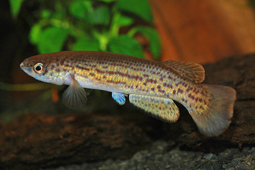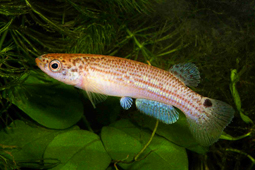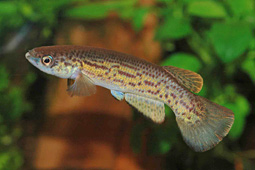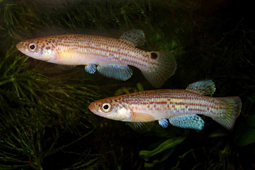History
Alternative name: Anablepsoides amphoreus.
From the central mountains in Surinam, not far from “Tafelberg” (a Table- mountain known as "Tepui" in the spanish language) a Dutch missionary, “Frater” Solanus Essers collected this species in 1976 and brought it to The Netherlands taking it to an aquarium shop during his vacation. The species was first reported by Geijkens in 1943. I had the opportunity to obtain all the 6 fishes that came to The Netherlands and was sure that the species was not known scientifically as yet. From the behaviour under aquarium conditions it was likely it had to be a species that dwells in running water and likes high oxygen levels. Strong current and temperatures around 22º Celsius did trigger the production of eggs. This is not the case for most of the other Rivulus species that live in calm or stagnant waters. During our trip to Surinam in 2000 Siegmund Sladkowsky from Germany and myself visited the Tafelberg location after all these years and found out that Rivulus amphoreus was indeed living in fast running waters with cool temperatures. Back in 1976 I did breed this fish and donated the wild fishes, preserved in alcohol, to Jean Huber, at that time doing his doctorate at the university of Nancy, France.
In his paper he described the fish, together with the beautiful Rivulus xiphidius, and he named them inspired by the ear-like (Greek ‘amphora’ handle) shape of embedded neuromasts on the side of the head, which was a unique feature for Rivulus at that time.
Reproduction
Keeping and breeding is easy but a tight fitting cover on the aquarium is necessary because their ability to jump, even through the smallest opening, is unbelievable.
This species can, if there is enough space for them, be housed in a tank with more than one male and several females. If separated before and brought together again however, they can be very aggressive towards each other and fight to become the dominant fish. The best way to produce numbers of fry is to put a pair or a trio in a small tank of about 10 litres with a small filter in it or with some aeration. On the bottom of the tank place some peat moss or dark gravel and a floating "mop" to give space for laying their eggs. The fish will, if they are fed a rich variety of live food, spawn during their whole adult life and produce daily between 5 to 15 eggs.
The eggs should be collected by hand and stored for about 14 days in a small container. Eggs are 1.6 mm and amber coloured. It is wise to add an anti fungus to the water you store the eggs in, to prevent fungal attacks.
After hatching the young fry can eat fresh artemia nauplii without any problem. It takes 4 to 5 months to raise them to maturity. Often the number of males far outweighs the number of females. For some species this can become a major problem for the breeder, as he has to raise many fry to be able to distribute a few pairs to other hobbyists. Recent personal tests found that lower pH levels during the incubation period gave higher percentages of females. To achieve this I used some peat moss that I added to the container with the eggs just before they are ready to hatch. This peat moss also is a good way to prevent eggs being attacked by fungus.
Their lifespan can be up to 3 years in captivity.Remarks :
Variations
Map
Meristics
Max. size 6.0 cm.
Dorsal 10.1,
Anal 17.0,
D/A 9.0,
LL scale count (average)48.0
Pre- dorsal length to % SL – 71.0 %
Depth to % SL – 21.0 %
Literature
Huber, J.H. 1979. A propos de quatre nouvelles Collections de Rivulus des Guyanes, avec Description de Rivulus xiphidius n.sp. et Rivulus amphoreus n.sp. Rev.fr.Aquariol, Herpet.,6:66, Fig.3.



